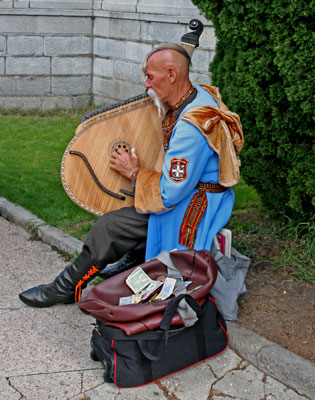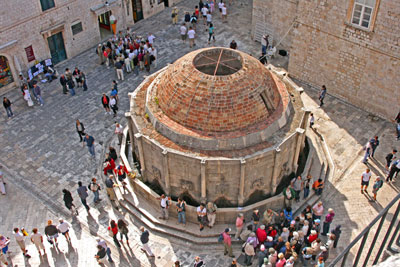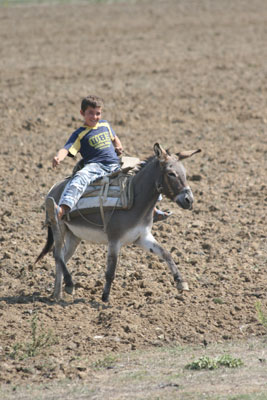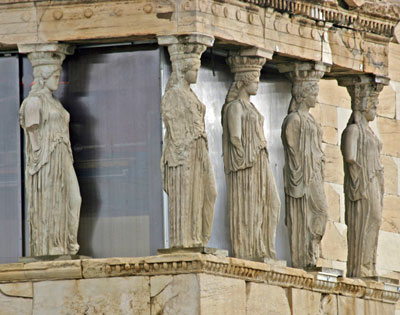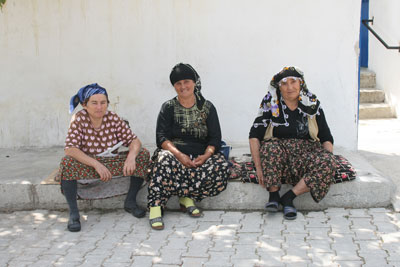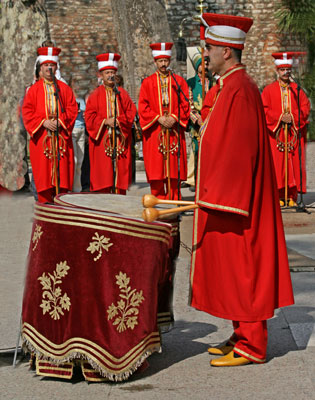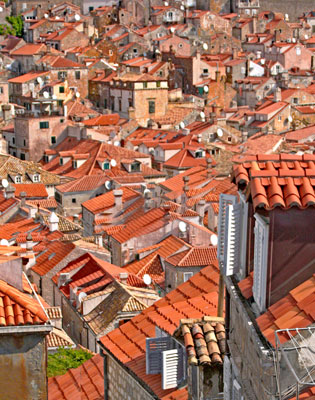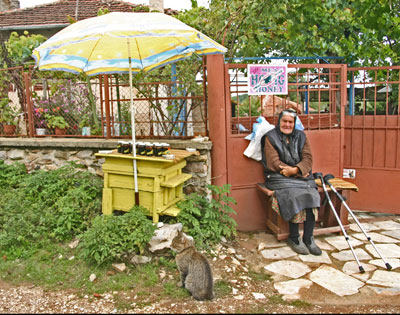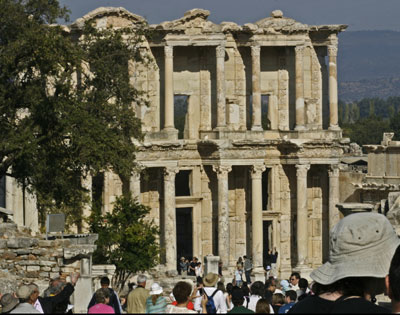Seven countries in two weeks on a tour-filled Black Sea cruise
by Joyce Bruck, Ocean Ridge, FL
I was to embark on a 14-day Holland America Line cruise through the countries of the Black Sea from the port city of Civitavecchia on Sept. 17, 2008. As a precaution, I always try to leave a one-day “fudge factor” in case something goes wrong, such as a missed or delayed flight, so I had booked an overnight at Hotel Traiano (phone +39 0766 544282, www.hoteltraiano.com), which I found on the Internet. I had arranged with the hotel for a driver to pick me up at Rome’s Fiumicino-Leonardo da Vinci Airport for the transfer to the hotel in Civitavecchia (E110, or $164), but where was he?
A rocky start
After clearing Immigration and Customs, I looked all over the arrival hall for my driver, but he was nowhere to be found. I dragged my baggage around for about 45 minutes before I began to panic.
For this reason, and others, I always travel with my four-band cell phone, which is supposed to work everywhere. Unfortunately, in my rush I had left it in my car in Miami.
After wandering around, I found another driver who was waiting for someone, so he called to check on my driver. It turned out he was just late (he said there was an accident on the highway), and we were united after another half hour. I was happy to be on my way.
However, instead of taking me to the Traiano, the driver took me to the brand-new Hotel Bramante (3 Via Olimpia; phone 0766 502407), which was a little outside of the city. He explained that the Traiano, though located more centrally, was having trouble with their air-conditioning, so I could choose to stay in either place.
The Bramante was a four-star establishment while its older sister was only a three-star, plus it had a nice view of the sea. Both included breakfast and transportation to the pier the following day at no charge.
Booked through Expedia.com, a single room at the Traiano cost $150.90 (plus $11.25 tax) for the night; this was accepted by the Bramante.
After an arduous walk into the city and back, with a little help from some locals, I encountered some other cruise passengers walking to dinner and asked if I could join them. We found a wonderful restaurant just down the road that was part of the four-star Sunbay Park Hotel. My dinner was a delicious plate of gnocchi with calamari (about $12).
To the ship!
After a good night’s sleep and a nice breakfast with delicious cappuccino, croissants, fruit, sweets and all of the trimmings, I was ready early for the transfer to the ship, the premium-class Prinsendam. My good-size cabin was in a nice location and had lots of storage space.
Through the course of the voyage I used a combination of means to see the best of each of the ports visited, including touring on my own, participating in ship’s tours and taking private tours arranged in advance from home. I prefer exploring independently, but in some places this was not feasible.
When arranging to meet a guide, I always e-mail a copy of my picture beforehand so they can find me quickly.
Croatia
At our first port, Dubrovnik, Croatia, I took the recommendations from a friend and a guidebook to see this UNESCO World Heritage Site without an organized tour. It was also suggested to visit early in the morning before it got too hot, which I did.
Since Dubrovnik’s Old City was close to our arrival pier, I traveled by public bus to the Pile Gate, one of the original four. Traveling with another woman from the ship and her mother, I visited the Franciscan Monastery (open 9 a.m. to 6 p.m.; admission, 10 kuna, or $2), with its cloistered gardens, the Romanesque arcades and a pharmacy that has been in continuous operation since 1317. Then we took a one-hour walk along the top of the stone wall surrounding the Old Town.
After more sightseeing and some lunch in one of the sidewalk cafés, we walked back to the ship past narrow, ancient alleys with apartments and small restaurants wedged side by side. Although it was an enjoyable day, there were thousands of people, mostly with large tour groups, seeing the sights. Not only could we hardly walk but it ruined much of the ambience.
Albania
Sarandë, the next port of call, was in a country I had never visited: Albania. Through the Internet I had arranged for a three-hour private tour by car to the city’s ruins and the countryside (E100, or $149). Once again my fellow passenger accompanied me.
I booked my tour with the tour company Sipa Tours (Corfu, Greece; phone/fax +30 2661056 415, www.sipatours.com), and our guide and driver were waiting for us at the dock with a private van. (This tour company was recommended by an ITN subscriber; see Jan. ’09, pg. 27).
Our first stop was the ruins of Butrint, the largest Roman archaeological site in Albania. Inhabited continuously from the seventh century BC until the 18th century AD, this UNESCO World Heritage Site includes a Roman amphitheater; an early-sixth-century circular baptistery; the Agora/Forum; the public bathhouse; the Great Basilica, and a number of other sites.
Seeing the ruins at the top of the hill is somewhat difficult because you have to walk uphill for about 150 steps, not to mention the climb back down. The most interesting part, though, is the lower section (described previously), which is recommended for people who have difficulties with walking.
The tour ended at the center of Sarandë with a visit to ruins of the Onhezmi Synagogue, built in the fifth century.
The Butrint ruins were interesting, but my favorite part of the tour was seeing two young boys on mules herding their flock of sheep through a pasture near the road.
Greece
The ship’s tour to Argostoli in Kefalonia, Greece, seemed to include the places I wanted to see at a reasonable price ($69 per adult), so I went with the group in a large bus.
It began with a scenic island drive through olive groves, vineyards and thick cypress glades as we climbed Mt. Ainos and passed the city of Sami, where “Captain Corelli’s Mandolin” was filmed. Our first stop was Melissani, an underground lake fed by subterranean channels. Partially open to the elements, the cave is visited by going down stairs to a manmade tunnel which leads to the shore of the lake.
From the shore, small boats rowed by master oarsmen took the group on a short ride on the lake. The light coming in from the cave’s entrance created the effect of dancing color on the ceiling, 300 feet above.
I really enjoyed our next stop, Fiskardo village (50 kilometers north of Argostoli), which is said to be the most picturesque village on the island. It is the only settlement that was not devastated by the 1953 Ionian earthquake.
The waterfront basin is bordered by multicolored tavernas, cafés, bakeries, markets and shops, and we had some free time there to stroll the area before our return to the port of Argostoli. At the request of two elderly Greek gentlemen, I joined them at their café table as they drank the usual Greek coffee and passed the day.
This was a lovely excursion; however, if I had it to do over, I would eliminate the cave visit and try to experience more of the rich local culture and scenery.
Turkey
Several years ago, on the recommendation of a well-traveled friend, I attended a promotional lecture given by a Turkish man named Bora Özkök, owner of Cultural Folk Tours (800/935-8875, www.bora
ozkok.com). So when the opportunity presented itself, I contacted his tour company to arrange a private tour for my stop in Istanbul, Turkey.
The fee of $270 for the 10 hours I was there included a guide, a driver with a van, dinner in a kebab restaurant overlooking the Bosporus and all admissions (some of which were expensive) to our agreed-upon destinations. At the time, gas was $12 per gallon in Turkey.
The tour was to cover most of the main attractions of central Istanbul — the Blue Mosque, the spice market, the underground cisterns, the Hippodrome, Topkapi Palace and Hagia Sophia — plus some places off the beaten track.
The guide was waiting at the pier with the van and driver when I disembarked. In order to beat tours from the several ships in the harbor, we first went to Topkapi Palace, the hub of the Ottoman Empire for over three centuries. We entered through the Imperial Gate, then visited the palace kitchens and bakery area. The life-sized picture of the chef in his costume of feathered hat, ballooned pants and curled shoes was quite impressive.
In the next building, the state treasury displayed huge diamonds and emeralds as well as armor and swords.
Also of interest were the harem section, the sultan’s mother’s area (with mannequins positioned as if they were bringing tea and refreshments) and the sultan’s bathroom with its ornate gold-and-marble fixtures.
Toward sunset, I was taken to a kebab restaurant with a beautiful view overlooking the Galata Bridge, the Golden Horn and the Bosporus. My tour guide ordered for me, and there were several courses that I did not recognize; the food was just average. By the end of dinner I was tired and ready to return to the ship.
Although the fee for my private tour was higher than the ship’s offering, I was able to see more and move quickly without the burden of traveling the old winding streets on a large tour bus. As we cut through the backstreets, I noticed the buses caught in traffic trying to get back to the various ships in port. I was glad I was not part of that mess.
The history of Turkey is complicated, so it helped to have a guide for background information. He also brought me to the location of the march of the Topkapi Palace guard, which I probably would have missed without a guide.
Trabzon
In Trabzon, Turkey, I elected to take a tour from the ship ($123 for 8½ hours) that visited the famous Sümela Greek Orthodox monastery; another Hagia Sophia church, the Ortahisar Mosque (aka Fatih Mosque) and the Atatürk Museum.
The main attraction, the Sümela Monastery, was built into a cave in the hills 1,000 feet above the valley 35 miles south of Trabzon. Our large tour bus took us part of the way up to a level with a restaurant and park. Smaller ferry buses went higher from there.
My guidebooks warned that the final walk uphill to the monastery cave was difficult, but they forgot to mention the steep incline, roots, small pebbles and slippery mud. Not being a hiker, I immediately decided that that particular walk was not for me. Those who went were very impressed with the beautiful interior frescoes in reds, blues and golds, though there was still some question as to whether it was worth the trek.
When the group returned to the starting point of the hike, a complete Turkish lunch, from soup and salad to rice pudding, was waiting for us. The park setting was beautiful, with a rushing stream and lush vegetation.
Later we visited a palatial building housing the Atatürk Museum. The beautiful white structure contained artifacts from the life and times of the country’s former ruler, Mustafa Kemal Atatürk, known as the founder of the Republic of Turkey. Pictures of him with world-renowned dignitaries and awards he had won, as well as personal items, were on display.
Even though I did not make it to the monastery, I still enjoyed the rest of the tour.
On to Russia
In Russia, the tour of Sochi, directly south of Moscow, began with a pleasant walk along the seaside promenade lined with magnolia trees. Later we drove to the Zelyonaya Roscha area, where Joseph Stalin’s dacha is located.
The original decoration of this dacha, plus its interior, the furnishings (some original) and a number of his personal belongings, gave us insight into that era. A wax figure of Stalin in the study area created an atmosphere of his presence.
After the tour of the house, we had wine and snacks served in the lovely hall. Surprisingly, the house is still in use and parts are available for rent.
The 3½-hour Sochi tour, which cost $67 per person, ended at the dock with time to spare, so I wandered off a bit on my own. However, as most of us did not have Russian visas, we were not allowed to leave the wharf.
Ukraine
Sevastopol, Ukraine, is located on the scenic southern Crimea coast along the road to Yalta. During both the Crimean War and World War II it was heavily bombarded, leaving mostly ruins.
This seaside resort was favored by the Russian and Ukrainian elite, who built palatial homes there, and both countries share in the current defense of the area. As the military port was closed to outside traffic until 1996, people there are not as accustomed to tourists as they are in most other places.
The first stop of our tour offered a view of the Swallow’s Nest, a castle that clings to a 124-foot-high cliff. Its turrets, spires and crenellations gave an impression of grandeur. From there the tour bus continued to the picturesque settlement of Massandra for a visit to Alexander III’s palace.
Designed by architects from France and Germany, it was acquired by Tsar Alexander III in 1889 to be used as his summer mansion. It subsequently became a summer dacha for the upper-echelon Politburo members during the Soviet times. The well-preserved original furniture and rich collection of arts enhanced the homey atmosphere of the palace. Surrounded by a small park with a fountain and open terrace, it offered splendid views.
After a short drive we arrived at the Livadia settlement, a summer residence of Russian tsars at the end of the 19th century, and visited the lavish White Palace, the location of the famous 1945 Yalta Conference. Strolling the grounds, we saw the bell tower and the lovely little Church of the Exaltation of the Cross, both built by Alexander II.
The tour ($164 for eight hours, with food) ended with a royal dinner accompanied by the music that was popular with the royal family.
Bulgaria
Upon my arrival in Nessebar, Bulgaria, my private guide, Patrick, was waiting for me on the pier. I found him through a referral from ITN reader Donna Perelman (July ’08, pg. 66). In my communications with him, I had explained that I wanted to go to a nontouristy village. According to Patrick, the nearest village that deserved attention and was nontouristy was Brashlyan, 95 kilometers south of Nessebar.
The March ’08 article by M. Lewis Stein (page 60) was also helpful in selecting my itinerary there.
After a few e-mails, we agreed on a price for the private tour to the remote village. He also arranged for us to have lunch in a typical house there.
The village dates back to the 1500s (or earlier), and some of the houses are being refortified and turned into simple bed-and-breakfasts. The way of life there did not seem to be altered much from the way it must have been decades ago.
As we walked through the unpaved streets, there were people selling honey in front of their cottages, chopping wood and washing clothes. Goats ran along the paths.
We had a lovely day, stopping whenever there was something interesting or picturesque.
After Brashlyan, we spent a couple of hours walking around the old walled town of Nessebar. Dating back to the sixth century BC, it is one of the oldest settlements in the Balkans.
This well-preserved museum town once contained some 40 churches and basilicas dating back to the Byzantine Empire. One of the more interesting churches still standing is St. Stefan. When I was there, they were restoring the beautiful frescoes.
The Old Town area is quaint but a bit touristy, catering to ship passengers as well as Europeans on vacation. The dollar went a bit further there than it did in other places.
If you are contemplating a trip to this area, I’d recommend Patrick (e-mail bulgariaprivateguide@gmail.com) for just a local trip or for a visit to all of Bulgaria and its bordering countries. He tailors trips to the travelers’ objectives for Bulgaria and has contacts in other countries, such as Romania.
He charged me E10 ($15) per hour plus E40 extra for gas for his car.
A return to Turkey
Kuşadasi was our last port of call. There was a full-day trip offered by Holland America that included most of the major sights in the area and lunch with local dancers for our entertainment for the reasonable price of $126 (7 to 7½ hours). The highlight of the tour was the visit to Ephesus, one of the best-preserved ancient cities in the world.
We strolled down the Marble Way, beginning at the Library of Celsius and Hadrian’s Temple and continuing to the Great Theatre, which was expanded by the Romans to a seating capacity of 25,000 in the first century AD. The Corinthian-style temple, dedicated to Hadrian, Artemis and the people of Ephesus, had beautiful reliefs on the ancient statues and friezes.
Although we were there in the shoulder season, the famous ruin was crammed with people, as Dubrovnik had been.
The tour continued to the Ephesus Museum, which contains original sarcophagi, pottery, statues and household items used in the daily life of the ancient city. The museum was worth the visit.
I think I would have enjoyed the day’s tour more if our guide had been better, and the large number of people in Ephesus was definitely a distraction. Perhaps if we went later in the day it would have been more interesting and better for photos.
Drawing to a close
We had had excellent weather throughout the trip, with cool mornings, warm afternoons and very little rain. For the last day of the trip I selected the package the ship offered with a short tour of Athens, including the Acropolis, Constitution Square and the Arch of Hadrian, ending with a transfer to the airport.
At the Acropolis, things went a little wrong. It was drizzling when we reached the hill, so the climb was somewhat slippery. Most people didn’t have proper gear, though some purchased umbrellas upon arrival. I, fortunately, had followed my “be prepared” motto and was wearing a waterproof jacket with a hood. Some people had not worn the proper shoes, and at least two members of other groups fell.
We made our way up the partially paved path to the Parthenon, dedicated to Athena, the patron goddess of Athens. This building, symbolizing power and wealth in ancient Athens, is an architectural masterpiece. Nearby is the Erechtheion temple with its famous porch of the Caryatids (six figures of maidens replace columns for support). Because of pollution, the original statues have been moved to the Acropolis Museum to protect against further damage.
Summing up
I enjoyed the cruise; however, I found the food to be very average. The menu selection was good, but the preparation was lacking — certainly not what I anticipated from a premium-class ship.
The itinerary, which was the main reason I selected this particular trip, included a variety of countries that I enjoyed, especially those I had not previously visited (Albania, Bulgaria and Ukraine).
There were usually several reasonably priced ship’s tours in each port, arranged to appeal to passengers with different objectives. Those I took were well orchestrated, making the most of the time in port. Restaurants in port that were included in the tours were well selected, offering a very good sampling of the local fare. My only problem was that, unless you took the expensive private van/car tours, transportation was in large 50-person buses, of which I am not fond.
The 2010 “Black Sea & Mediterranean” cruise-only price starts at $2,799 per person, double. For more information, contact Holland America Line (877/932-4259, www.hollandamerica.com).


